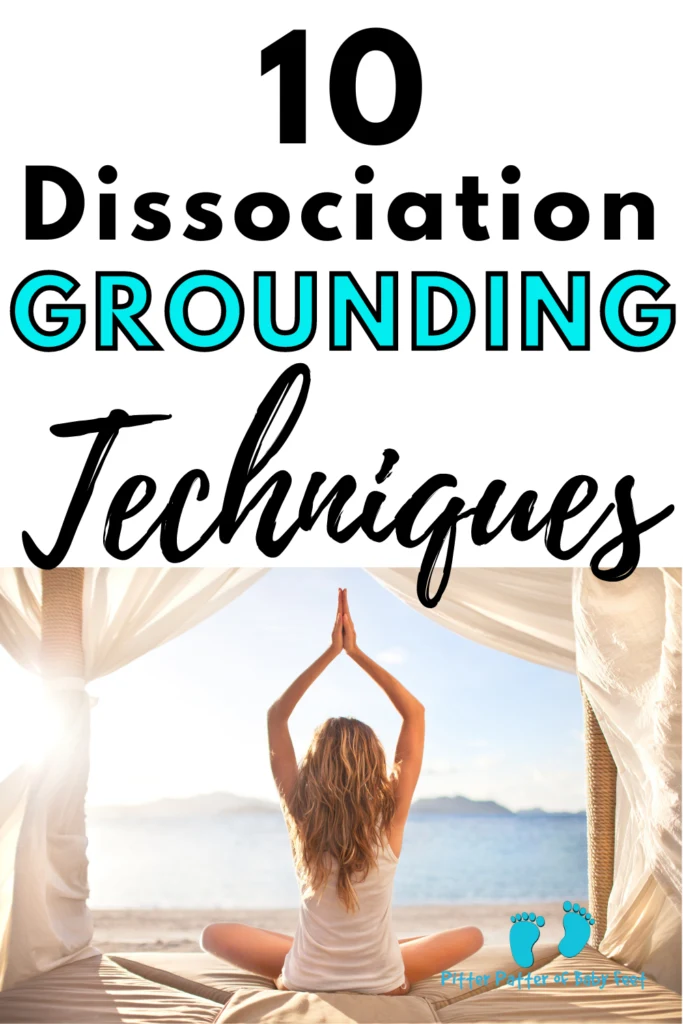Living with dissociation is no way to live. This type of disorder leaves you feeling like your environment, people and even your own identity are not real.
Instead of being present in the moment you’re in, your brain dissociates and provides a “safe haven” to protect you from stressful events, current and/or past trauma.
Although this may seem like a God send for some people, over time dissociation can disrupt all areas of your life.
Grounding techniques can be used during dissociation episodes in which you feel disconnected from your environment or yourself.
Disclosure: Bear in mind that some of the links in this post are affiliate links and if you click on them to make a purchase I will earn a commission. Keep in mind that I link these companies and their products because of their quality and not because of the commission I receive from your purchases. The decision is yours, and whether or not you decide to buy something is completely up to you.
What Is Dissociation?
Dissociation Identity Disorder is an umbrella term used to describe a group of mental health disorders that cause a person to feel disconnect from themselves, their environment, and the people around them.
These types of disorders are caused by extreme stress and/ trauma. It is the brain’s way of taking a break and saving the body and mind from relieving the trauma or stress over and over again.
Although there are different forms of dissociation, the disorder shows up differently in each individual. Many people are just seen “checking out” or “zoning out.”
But internally the individual with dissociation is experiencing a break from their own trauma and stress. It is a way for the brain to save itself from the burden.
This does not mean an individual with dissociation is losing touch with reality.
While this can happen in some experiences, it’s important to know that for most people this is not the case and a “psychotic break” should never be assumed by anyone except diagnosed by a healthcare professional.
What Are Grounding Techniques?
Grounding techniques are a tool used by an individual who’s experiencing dissociation.
When a dissociative state has hit hard and you no longer feel connected to yourself or your surroundings, then grounding techniques can help bring your brain back to feeling connected with the world.
Dissociative disorders are commonly associated with other disorders including types of anxiety and post-traumatic stress disorder, therefore grounding techniques or skills can help manage strong emotions and flashbacks associated with anxiety and PTSD.
Related Articles: Dissociation: Definition, Symptoms And Causes
Best Products For Deep Pressure Therapy
Depression Symptoms No One Talks About
Dissociation Grounding Techniques
Get In Touch With Nature
Literally! Go outside and sit in a grassy area. Try gardening and dig your hands in the dig. Go to a nearby lake or beach and dig your feet and hands in the sand.
Why do this? Connecting with nature through touch allows you to physically “feel” your environment.
Through physically touching the ground, you tactile sense is activated and helps your brain register that the environment around you is real.
Therefore, you care connected to your environment. This will cause your brain to possibly “snap out” of its dissociative state.
Weighted Blanket
A weighted blanket provides a type of therapy called deep pressure therapy. When firm pressure is applied to the body, the parasympathetic nervous system is activated creating feelings of being “at rest” and providing a state of calmness.
Deep pressure therapy can provide the following benefits:
~ Relieves anxiety
~ Increases melatonin production for increased sleep
~ Increased feelings of happiness
~ Increased focus
For someone who is dealing with dissociation in the form of derealization, a weighted blanket is an amazing therapeutic tool to help me feel grounded and calm.
Since dissociation is connected to extreme stress, using a weighted blanket is one of the best dissociation grounding techniques to help bring my brain back to reality.
After about 20 minutes of laying under a weighted blanket I find myself slowly coming out of the dissociative state with a sense of calmness.
My mind is no longer panicking and feeling like I don’t know where I am or what I’m doing.
It brings me out of a confused and hectic dissociation state and returns me back to my emotional baseline.

Hold An Ice Cube
Have you ever splashed cold water on your face? How did it make you feel? Awake? Alive? That’s the benefit of introducing cold water against the skin.
It has a way of “shocking” your body and mind back to reality.
Although you can always splash cold water on your face, the ice cube method tends to have a longer lasting effect as a grounding technique for dissociation.
When you feel yourself not knowing where you are, what is real, or even who you are, grab and ice cube and hold it in your fist. Now, focus on the coldness it gives to your hand.
With an ice cube in hand, your brain wakes up out of the dissociation and recognizes that something extremely cold is touching the body.
While this is a good method for relieving dissociation, be careful with holding ice directly against the skin.
Only hold it until you feel aware of yourself and your surroundings. You do not have to keep holding the ice cube till it melts!
Stretching
Grounding is simply of way of being present in moment. Connecting with your surroundings and yourself.
One of the best and simple dissociation grounding techniques is movement!
Movement through stretching is a calm and easy way to relieve extreme stress that may be bottled up not only in the brain, but the body as well. Yes, your body stores stress too!
Stretching movements not only work as a fast way to pull yourself out of a dissociative state, it can also be used as a long-term grounding technique.
You can make stretching movements like yoga part of your daily routine to possibly minimize the amount of dissociation episodes you have.
According to Good Therapy, there are two grounding movements that are shown to bring focus and reduce anxiety and fearfulness in those with dissociation.
Try these two stretching exercises to feel grounded during a dissociative episode:
- Jump up and down and side to side. Focus on how you feel when your feet hit the ground. How your breath quickens and how your heart rate increases.
- Stand with you feet shoulder width apart and twist your upper torso to rotate your hip joints.
5-4-3-2-1 Techniques
This is one of the dissociation grounding techniques that is becoming more popular not only for dissociation but also for anxiety, panic attacks, and PTSD.
Although this method is highly effective for calming the mind and grounding yourself, it is a grounding tool that needs to be used in the moment of panic or dissociation.
That’s the only downfall to this technique! When your brain and body are dissociated or in full panic mode, it’s hard to remember this technique.
If you’ve experienced dissociation at all, you are familiar with the feeling of “checking or zoning out.” Your mind goes void to relieve itself from extreme stress or trauma.
During this moment it’s hard to recall any information, let alone this long-form method of a grounding technique.
But none the less, it is effective! To help you remember this grounding technique, I would highly suggest to keep the sequence written down on a piece of paper in your purse or wallet.
Even better, find a graphic of the 5-4-3-2-1 method and keep it as your phone’s lock screen!
Here is how to do the 5-4-3-2-1 technique:
~ Name 5 things you can see
~ Name 4 things you can touch
~ Name 3 things you can hear
~ Name 2 things you can smell
~ Name 1 thing you can taste
Related Articles: How To Recognize Anxiety Triggers
How To Tell If You Have Social Anxiety Disorder
45 Journal Prompts For Mental Health
Chew Gum Or Candy
This is a dissociation technique I’ve found effective when driving. Since I can become dissociated while driving, it can become frightening because I forget where I am going and sometimes lose small bits of memory.
To conquer this, I’ve found munching on candy to be an effective way to regain focus while traveling.
I know it’s not good for the waistline, but chewing candy or gum does help to bring things back into focus for me and could for you as well.
Amazingly, candy does help produce increased focus for the brain due to the high sugar content.
Reflective Journaling
Reflective journaling is simply a daily journal session in which your write down your inner most thoughts, feelings, fears, happiest moments and more.
Make journaling apart of your everyday routine to conquer dissociation. Instead of writing about your daily activities alone, focus on writing about dissociation in particular…
Journal about…
~ Past and present stressors in your life
~ What triggers dissociation for you
~ Trauma you’ve experienced
You will be surprised at how much reflective journaling can relieve stress, reduce anxiety, and work through past and present trauma.
Check In Questions
Check in questions are all about being in the moment. When you feel dissociation coming on or are currently in a state of dissociation, try asking the following questions…
- Where am I
- How am I feeling
- Where am I going
- What am I doing or trying to do

Breathing Techniques
Everyone knowns deep breathing can be used to help calm panic attacks and relieve stress. But using breathing techniques during these chaotic moments like a panic or dissociation episode is hard to focus on breathing.
But with practice and time you can learn to implement breathing techniques during these chaotic moments.
Instead of just deep breathing as a grounding technique, try one of the following techniques that incorporates breathing with counting to help refocus your mind.
Box Breathing
- Breath in for four seconds
- Hold your breath for four seconds
- Breath out for hour seconds
- Hold for four seconds
- Repeat as many times as needed
5 Finger Breathing
- Inhale through your nose as you look and focus your eyes moving up your finger
- Exhale through your nose as you follow your eyes down your finger
- Reap until you have “traced” your yes up and down each finger while breathing
Create A Safety Plan
Dissociation is a disorder that’s concerning in a way that it can cause harm especially when time lapses and amnesia are involved.
If you’ve experienced memory loss and/or time lapses it’s important to have a safety plan in place.
One of the best ways to do this is by confiding a friend or family member.
Help them understand what is going on and things you are concerned about.
They can also help you keep in communication daily to make sure you are aware of where you are and what you’re doing.
If you are experiencing time blocks and amnesia you can also ping your location to a friend or family member or have them trace your phones location with a tracker app.
While this may seem drastic, what’s most important is your safety!
Final Thoughts
Dissociative Identity Disorder is an umbrella term for a set of disorders that are closely related.
While many experience the most common forms like depersonalization and derealization, other disorders like dissociative amnesia and multiple identity disorder can have devasting effects in a person’s life.
What’s most important about dealing with dissociation is learning the reasons behind the dissociation and what triggers it.
Finding the root cause of dissociation is never easy, but in the mean time dissociation grounding techniques are an incredibly useful tool to ground you back to reality.

Works Cited
Grounding techniques for anxiety, PTSD, and trauma (medicalnewstoday.com)
Keep Calm and Carry On: Returning to the School Building (thesienaschool.org)

